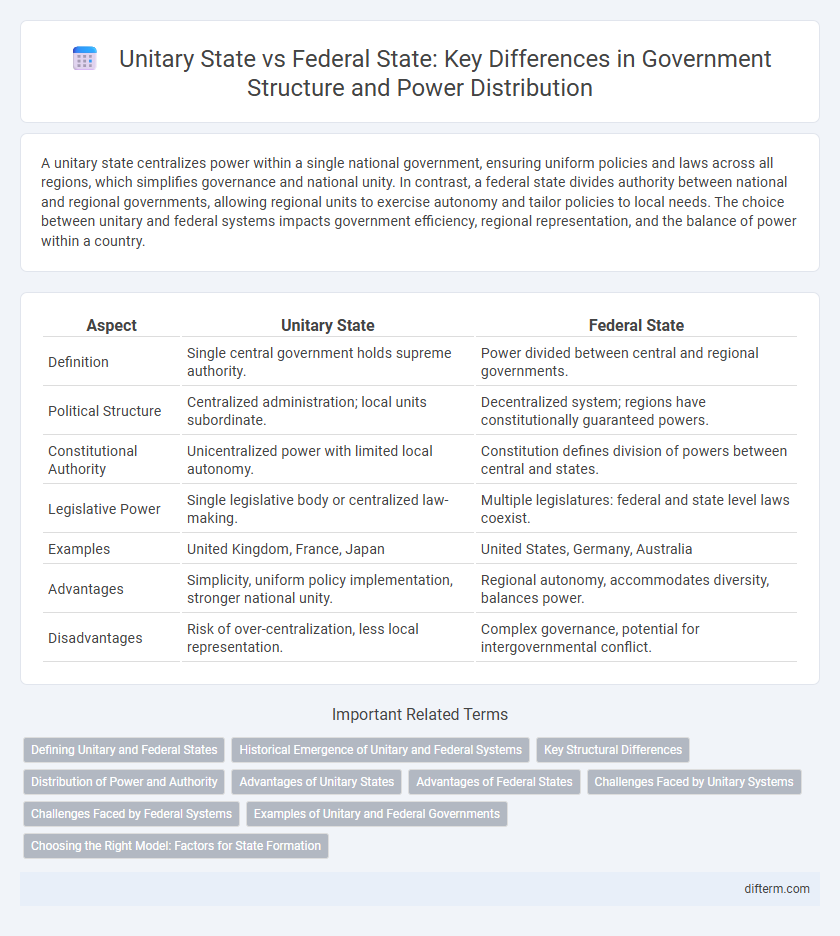A unitary state centralizes power within a single national government, ensuring uniform policies and laws across all regions, which simplifies governance and national unity. In contrast, a federal state divides authority between national and regional governments, allowing regional units to exercise autonomy and tailor policies to local needs. The choice between unitary and federal systems impacts government efficiency, regional representation, and the balance of power within a country.
Table of Comparison
| Aspect | Unitary State | Federal State |
|---|---|---|
| Definition | Single central government holds supreme authority. | Power divided between central and regional governments. |
| Political Structure | Centralized administration; local units subordinate. | Decentralized system; regions have constitutionally guaranteed powers. |
| Constitutional Authority | Unicentralized power with limited local autonomy. | Constitution defines division of powers between central and states. |
| Legislative Power | Single legislative body or centralized law-making. | Multiple legislatures: federal and state level laws coexist. |
| Examples | United Kingdom, France, Japan | United States, Germany, Australia |
| Advantages | Simplicity, uniform policy implementation, stronger national unity. | Regional autonomy, accommodates diversity, balances power. |
| Disadvantages | Risk of over-centralization, less local representation. | Complex governance, potential for intergovernmental conflict. |
Defining Unitary and Federal States
A unitary state centralizes authority within a single, sovereign government that holds the primary legislative power, often delegating limited powers to local governments without constitutional guarantees. A federal state divides sovereignty between a central government and constituent political units, such as states or provinces, each possessing constitutionally protected powers and autonomy. This division of power in federal states aims to balance national unity with regional self-governance, contrasting with the concentrated control found in unitary systems.
Historical Emergence of Unitary and Federal Systems
Unitary states emerged historically from centralized monarchies where power was consolidated to maintain uniform governance, evident in countries like France and Japan. Federal systems developed as compromises in diverse, geographically expansive nations such as the United States and Germany, allowing regional authorities to exercise autonomy within a unified legal framework. The historical emergence of these systems reflects varying priorities in balancing national unity and regional diversity.
Key Structural Differences
A unitary state centralizes authority, with a single governing body holding ultimate power and local governments operating under its discretion, while a federal state divides sovereignty between national and regional governments, each with constitutionally guaranteed powers. In unitary states, policy decisions are uniform across the country, enabling streamlined governance but limited regional autonomy; federal systems allow regions to enact laws tailored to local needs, fostering diversity but sometimes complicating national policy coherence. The constitutional framework in federal states explicitly allocates responsibilities to different levels of government, contrasting with the hierarchical administrative structure typical of unitary states.
Distribution of Power and Authority
In a unitary state, power and authority are centralized within a single national government, which holds the ultimate decision-making control and can delegate responsibilities to local governments without surrendering sovereignty. In contrast, a federal state constitutionally divides power between a central authority and constituent political units, such as states or provinces, granting each level autonomous legislative powers and legal jurisdiction. The division of powers in federal systems ensures a balance between unity and regional diversity, preventing excessive concentration of authority in the central government.
Advantages of Unitary States
Unitary states offer streamlined governance by centralizing authority, which enhances policy consistency and reduces administrative costs. This structure enables rapid decision-making and uniform implementation of laws across all regions, minimizing bureaucratic delays. Centralized control also facilitates national unity and simplifies the management of public services.
Advantages of Federal States
Federal states provide enhanced regional autonomy, allowing constituent units to tailor policies to local needs and cultural preferences, which promotes political stability and citizen satisfaction. This decentralized governance structure fosters innovation by enabling states to experiment with diverse policy approaches, leading to more effective and adaptive solutions. Shared sovereignty between central and regional governments improves conflict resolution by balancing power distribution and protecting minority rights.
Challenges Faced by Unitary Systems
Unitary states often encounter challenges related to centralized governance, including limited regional autonomy and slower responsiveness to local needs, which can lead to dissatisfaction among diverse populations. The concentration of power in a single national government may result in inefficiencies in addressing regional disparities and reduced adaptability to local issues. These systems face difficulties in balancing uniform policy implementation with the varied demands of different geographic and cultural areas.
Challenges Faced by Federal Systems
Federal systems encounter challenges such as coordinating policies across diverse regional governments, which can lead to inconsistencies in law enforcement and public services. Fiscal disparities between wealthy and poorer states create difficulties in equitable resource distribution and balanced economic development. Managing conflicting interests between central and subnational authorities often results in political gridlock and delays in national decision-making processes.
Examples of Unitary and Federal Governments
Unitary states such as France, Japan, and the United Kingdom concentrate power within a central government, ensuring uniform policies across all regions. Federal states like the United States, Germany, and Australia distribute authority between national and regional governments, allowing states or provinces to enact their own laws. This division reflects differing approaches to governance, with unitary systems favoring centralized control and federal systems promoting regional autonomy.
Choosing the Right Model: Factors for State Formation
Selecting the appropriate state model depends on factors like population diversity, geographic size, and administrative efficiency. Unitary states centralize authority, promoting uniform policies, which suits smaller or culturally homogenous nations. Federal states delegate power to regional governments, accommodating diverse identities and local autonomy, often benefiting large or multiethnic countries.
unitary state vs federal state Infographic

 difterm.com
difterm.com